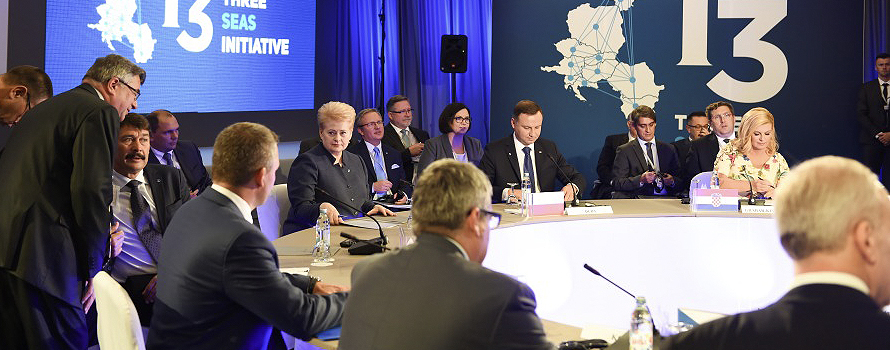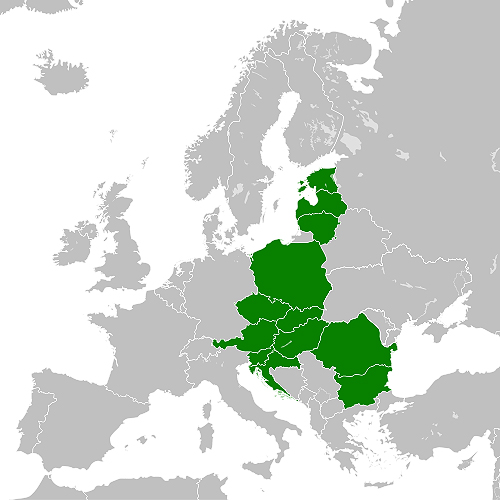Introduction to the cooperation project of 12 EU countries located between the Baltic, Adriatic and Black Seas.
In addition to the East-West integration efforts inherent in the enlargement of the European Union, several North-South connection initiatives have been added between the countries of Central and Eastern Europe, such as the Three Seas Initiative. The goal is to overcome the deficit in road infrastructure and improve connections between these nations, which will enhance cooperation in the region and in the EU as a whole.

▲First meeting of the new forum, in the Croatian city of Dubrovnik, in August 2016 [i3].
article / Paula Ulibarrena
What is it and what is its purpose?
It is an initiative of Poland and Croatia that brings together 12 countries located between the Baltic, Adriatic and Black Seas and is therefore also known as the Baltic, Adriatic, Black Sea (BABS) Initiative.
The main goal is to promote greater cooperation between these countries of the European Union in the development infrastructure, economic development , economic cooperation and, above all, in energy resources. Polish President Andrzej Duda expressed the hope that the Three Seas Initiative will contribute to the modernization, integration and unification of Central Europe, Eastern Europe and the entire European Union.
How and where was this forum born?
Since the fall of the Berlin Wall, much progress has been made towards a united, free and peaceful Europe. The entrance of Central European countries entrance the European Union and NATO has contributed to the security, stability and prosperity of the entire continent. But this work is far from complete. And the cohesive role played by infrastructure will be crucial in achieving this.
For more than half a century, efforts to develop European connections and infrastructure focused on the East-West axis. After the fall of the Wall, governments in the region focused on integrating their economies into Western markets, leaving the development of a North-South interregional infrastructure on the back burner. After decades of disinvestment, a major effort has been made in the last twenty years to catch up: 5,600 kilometers of freeway have been built. But the imbalance between the two Europes is still notorious: a citizen of old Europe has, on average, twice as many kilometers of freeway as a citizen of Central Europe.
|

▲Wikimedia Commons [JayCoop].
|
With the goal of reversing the status, the presidents of Poland and Croatia, Andrzej Duda and Kolinda Grabar-Kitarović, respectively, launched in 2015 a project for the construction of energy, transport and telecommunications infrastructure in Central Europe. They called it the Three Seas initiative.
By whom is it formed?
The initiative aims to modernize economic links between the twelve EU nations located between the Baltic, the Black Sea and the Adriatic Sea (Austria, Bulgaria, Croatia, the Czech Republic, Estonia, Hungary, Latvia, Lithuania, Poland, Romania, Slovakia and Slovenia). This region accounts for 28% of the European Union's territory and 22% of its population. But it accounts for only 10% of its GDP.
In 2016 Poland and Croatia were joined by most Eastern European countries: Austria, Bulgaria, Slovakia, Slovenia, Estonia, Hungary, Latvia, Lithuania, Czech Republic and Romania. Thus a north-south axis that, with the exception of Austria, corresponds to the former communist countries.
The so-called Three Seas Initiative held its first session on August 25-26, 2016 in Dubrovnik and ended with a declaration of cooperation in economic subject , especially in the field of energy, transport and communications. In addition to the member countries, representatives of the Chinese Ministry of Foreign Affairs and the US National Security committee attended as guests.
The second meeting took place on July 6-7, 2017 in Warsaw, with US President Donald Trump as a guest. In fact this visit meant a certain snub to other EU countries.
The third meeting will take place in Romania in 2018, although the city has not yet been fixed.
How is it financed?
150 billion from the Structural Funds, plus additional money from the Connecting Europe Facility and the European Investment Bank. However, more than 384 billion still needs to be invested in another 2,000 projects to fill in or modernize these corridors.
An investment of this amount is beyond the possibilities of public institutions, so both infrastructure companies and financial institutions will have to play a fundamental role. To date, this subject of financing has been much less important than state contributions. However, the increase in public debt makes it increasingly interesting to rely on sources that minimize the impact on public accounts.
Projection
Faced with this magnitude of resource requirements, the question arises as to whether Central Europe is really an attractive market for investment. In this respect, two points can be made. This is a region with, firstly, very good economic growth prospects (it is expected to outpace Old Europe over the next five years), and secondly, with a construction sector that is expected to grow at an average annual average of 3.1% (compared to 2.3% for Western Europe), according data BMI Research. This is certainly attractive for investors.
The other side of the story is that we are still an emerging region. And, of course, this not only generates reserves, but also carries a higher level of risk. In this sense, we also have very different situations depending on which country in the region we are looking at. For example, Estonia is currently what investors call a "sweet spot", with very high returns and low risk. But it is the only country in the region in this category. There are countries - such as Lithuania, Croatia, Slovakia and Slovenia - where the risks are equivalent to those of Greece or Italy, but the returns are relatively low. And others have the opposite problem: high returns but too much risk.
The experience of those players already present in this area -some of them Spanish, such as Ferrovial, Bankia or BBVA-, shows that although each country presents important peculiarities, some common risks can be mentioned. To mention them briefly: lack of political support; non-transparent regulatory regimes; very complex contracting processes -such as PPPs and concessions-; lack of projects with the necessary level of maturity to arouse the appetite of investors, and the lack of skill of the public sector in these countries to take advantage of private-sector funding schemes, among others.
In an increasingly competitive and global Economics , the prosperity and well-being of a united Europe will depend on how quickly it adapts to today's world. In this process, building a connected, safe, affordable and sustainable transport network that connects the EU from north to south is a core topic. Doing so will have a direct impact on increasing the competitiveness of all European countries and, consequently, on the economic growth of Europe as a whole.